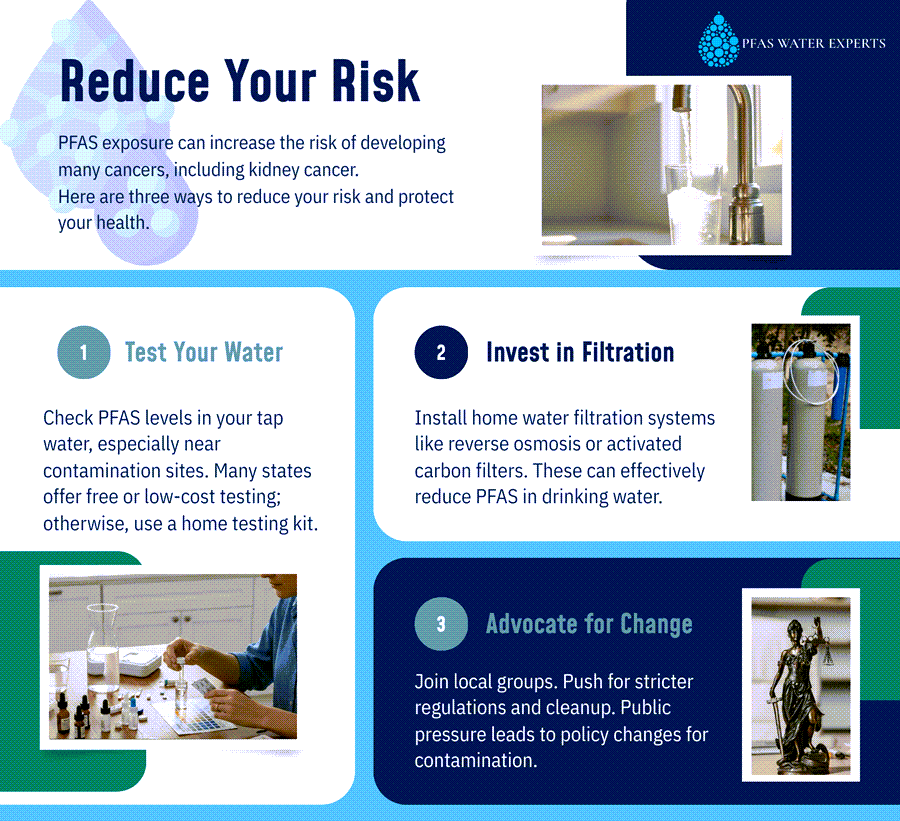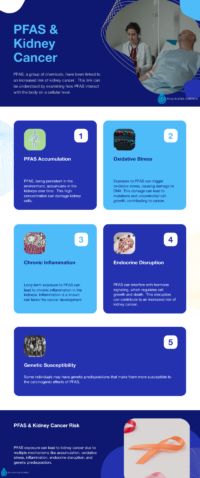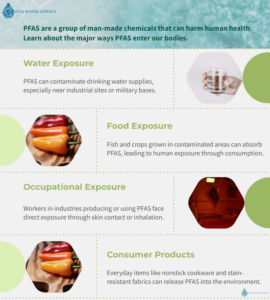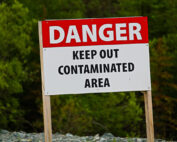Introduction
PFAS (per- and polyfluoroalkyl substances), often called “forever chemicals,” have raised significant health concerns due to their persistence in the environment and their links to various diseases. Among the most alarming associations is the increased risk of kidney cancer, particularly in communities exposed to high levels of PFAS through drinking water, occupational hazards, and environmental contamination.
This article delves into the connection between PFAS and kidney cancer, offering an in-depth look at the science, affected populations, and what can be done to mitigate risks.
The Scientific Evidence Linking PFAS to Kidney Cancer
Epidemiological Studies
Numerous studies have established a strong correlation between PFAS exposure and kidney cancer:
- C8 Health Project: One of the most comprehensive studies on PFAS exposure, conducted in the mid-2000s, focused on residents near the DuPont Washington Works facility in Parkersburg, West Virginia. The project tracked over 69,000 residents and found a clear association between high levels of PFOA (a type of PFAS) in drinking water and a significantly increased kidney cancer incidence compared to unexposed populations (Barry et al., Environmental Health Perspectives, 2013, DOI:10.1289/ehp.1205829). This study has become a cornerstone of understanding PFAS-related health risks.
- Studies in Military Populations: Research on military personnel stationed at contaminated bases, such as Wurtsmith Air Force Base and Camp Lejeune, has shown elevated rates of kidney cancer compared to the general population. These studies highlight the role of AFFF in contaminating military base water supplies as well as local water supplies outside of military bases.
- Global Perspectives: A review of international studies in both Europe and Asia have revealed similar findings in areas with PFAS contamination, suggesting that the kidney cancer link is not geographically isolated but a global concern.
Biological Mechanisms
The link between PFAS and kidney cancer can be attributed to several biological mechanisms:
- Accumulation in the Kidneys: PFAS are filtered through the kidneys as part of the body’s natural detoxification process. Over time, this filtering mechanism leads to a high concentration of PFAS in the renal tissue, where prolonged exposure can damage cellular structures and initiate carcinogenesis.
- Oxidative Stress and DNA Damage: PFAS exposure has been shown to induce oxidative stress, which creates reactive oxygen species (ROS) that damage DNA. This damage can result in mutations that lead to uncontrolled cell growth, a hallmark of cancer.
- Chronic Inflammation: Persistent exposure to PFAS may lead to inflammation in renal tissues. Chronic inflammation is a known precursor to cancer, as it promotes an environment conducive to tumor growth.
- Endocrine Disruption: PFAS interfere with hormone signaling, including those hormones that regulate cellular growth and apoptosis (programmed cell death). This disruption can lead to the unchecked proliferation of kidney cells, increasing cancer risk.
- Genetic Susceptibility: Emerging research suggests that individuals with certain genetic predispositions may be more vulnerable to the carcinogenic effects of PFAS. Studies are ongoing to identify genetic markers that could help predict risk levels.
How PFAS Enter the Body
PFAS enter the human body primarily through:
- Drinking Contaminated Water: This is the most common exposure route. PFAS leach into water near industrial sites or military bases that use products with high concentrations of toxic PFAS. Many communities near military bases, industrial sites, and firefighting training areas have reported elevated PFAS in their water supplies.
- Ingesting Contaminated Food: Fish and crops grown in areas with PFAS-contaminated soil or water can carry the chemicals.
- Occupational Exposure: Workers in industries that produce or use PFAS face direct exposure.
- Consumer Products: Everyday items like nonstick cookware and stain-resistant fabrics can leach PFAS into the environment.
Once in the body, PFAS accumulate in the bloodstream and organs, including the kidneys, where their long-term presence can lead to harmful health effects.
Communities at Risk
Hotspots of PFAS Contamination
Certain areas in the U.S. have become synonymous with PFAS contamination due to industrial activity and firefighting foam use. These include:
- Parkersburg, West Virginia: Residents near the DuPont plant were exposed to PFOA for decades, leading to significant health issues.
- Hoosick Falls, New York: PFAS contamination in the village’s water supply has been linked to higher cancer rates.
- Military Bases: Hundreds of US military bases throughout the country have been identified as PFAS hotspots due to extensive use of AFFF.
Vulnerable Populations
While PFAS exposure poses risks to everyone, certain groups are particularly vulnerable:
- Firefighters: Frequent use of AFFF increases their exposure.
- Industrial Workers: Employees at PFAS manufacturing or processing plants face direct contact with the chemicals.
- Children and Pregnant Women: Developing bodies are more susceptible to the harmful effects of PFAS, including potential generational impacts.
Current Regulatory and Legal Actions
Regulatory Actions
- EPA Guidelines: The Environmental Protection Agency has proposed strict limits for PFAS in drinking water, though enforcement remains inconsistent.
- State-Level Efforts: States like Michigan, New York, and Vermont have adopted more stringent PFAS regulations.
- International Bans: Some countries have restricted or banned the use of certain PFAS compounds, pushing for safer alternatives.
Ongoing Lawsuits for PFAS Kidney Cancer Claims
Aqueous film-forming foam (AFFF), a firefighting foam widely used by military personnel, firefighters, and airport staff, has been identified as a major source of PFAS contamination. Scientific research has linked AFFF exposure to several cancers, including kidney cancer.
Currently, there is an ongoing lawsuit that is seeking compensation for individuals diagnosed with kidney cancer and other PFAS-related illnesses due to prolonged exposure to AFFF.
Who qualifies:
Individuals, including military personnel and their dependents, firefighters, and industrial workers, who were regularly exposed to AFFF and later diagnosed with kidney cancer.
Legal Status:
As of 2025, the lawsuit is currently in multi-district litigation (MDL), consolidating numerous claims against chemical manufacturers such as 3M and DuPont.
How to Register:
Potential claimants can sign up and learn more about their eligibility by visiting the AFFF lawsuit registration page: AFFF Lawsuit Registration
PFAS Kidney Cancer Lawsuit FAQs
Reducing Your Risk
Testing Your Water
If you live near a known contamination site, consider testing your water for PFAS levels. Many states offer free or low-cost testing programs.
If testing is not offered in your area, you can test your it yourself with a commercially available water testing kit for PFAS.
Investing in Water Filtration
Home water filtration systems, such as reverse osmosis and activated carbon filters, can effectively reduce PFAS levels in drinking water.
Advocating for Change
Join local advocacy groups to push for stricter regulations and cleanup efforts in contaminated areas. Increased public pressure has already led to significant policy changes.

While the link between PFAS and kidney cancer is well-established, much work remains to mitigate the impact of these harmful chemicals. Continued research, stronger regulations, and increased public awareness are critical to protecting communities from PFAS exposure. For those already affected, early detection and medical intervention are key to improving outcomes.
As we push for accountability from polluters and greater government action, it is crucial to support the individuals and families bearing the brunt of PFAS contamination. By addressing the issue at its root, we can work toward a future where the risks of PFAS-related diseases are drastically reduced.






